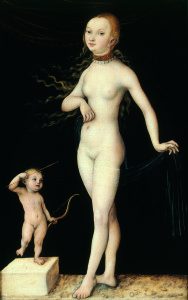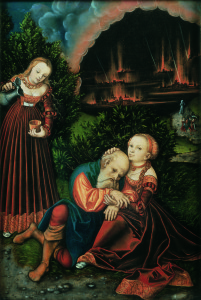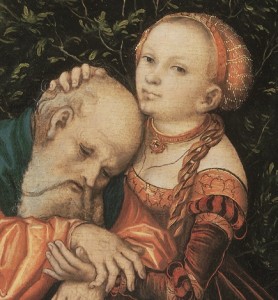The fearful consequences of the serpent’s temptation of the biblical Eve come down to us from the King James Bible, in graphic and stirring prose:
And the LORD God said unto the serpent, Because thou hast done this, thou art cursed above all cattle, and above every beast of the field; upon thy belly shalt thou go, and dust shalt thou eat all the days of thy life
Such are the wages of seduction; brought to bear, generation upon generation, upon those that both promote and practice its shameful guile.
* * * * *
Now walk with me for a moment. Follow me into the Northern European gallery at Compton Verney. Stand with me before Venus and Cupid, and wonder. Wonder at the hand that painted, and the mind that conceived. Wonder at the meaning and the method. Not least wonder at the consequence, for viewer and artist alike.
Lucas Cranach the Elder painted this image of Venus and Cupid around 1525. Consummate artist and businessman, he was in all likelihood responding to the dual impulses of man’s earthly weaknesses, conjoined in the single word desire; desire of the senses, and desire of money. One exchanged for the other; an artistic, entrepreneurial, and sensual consummation of different men’s needs. For one the gratified longing, for the other a heavy purse.
During Cranach’s lifetime the Protestant Reformation precipitated great change in Northern Europe, both social and artistic. In particular the accepted wisdom around the second commandment, “You shall not make for yourself a graven image….” was reassessed by Luther, whose new interpretation proclaimed that if anyone revered art more than was deserved, the fault lay with the viewer and not the art or artist. Cranach, a friend of Luther’s, embraced this reinterpretation, if not with impunity, then with alacrity, enabling a previously unseen boldness and eroticism in his paintings; and satisfying a lucrative market for his works amongst a broadly sympathetic and wealthy clientèle.
So let us return to Venus and Cupid. Here she stands, at first glance an embodiment of womanly beauty, and object of male desire. She, or rather should we say Cranach, presents an image laden with the symbolism of the erotic. Venus is naked; well yes, but not quite. Whilst retaining little dignity, she nonetheless retains sufficient embellishments to fan the flames. The jewelled collar, the strategically positioned diaphanous veil, the vestigial traces of a painted-over hat, do no more than heighten the tension, and serve to animate the senses. Meanwhile Cupid, with transparent intent, strategically points his arrow.
But Cranach employs greater subtlety yet in his portrayal of the figure. The elongated, somewhat mannerist, yet strangely androgynous figure, serves to enliven our curiosity, and thereby feed our fascination. The purchaser, and now the later viewer, is invited to admire and desire. And yet Venus’ expression seems to belie this sentiment. Her face reveals a certain sweetness, if not innocence, although her eyes confidently meet ours. She engages our stare with no hint of coyness, yet her demeanour is self-effacing. And whilst the painting bears no caption, it barely conceals an implicit Noli me tangere (touch me not). We stand here observing the intangible, the desirable, but perhaps most significantly, the unattainable. And upon Cupid’s plinth we see, though barely, Cranach’s cipher, diminutive though significant.
In 1508 Cranach was awarded by the Elector the heraldic device of a winged serpent, and used it as his device on all subsequent paintings. Yet in this picture the winged serpent is reduced to a diminutive squiggle on Cupid’s plinth; an emasculated emblem, symbolic of the observer’s denial of any tangible satisfaction. This may be a perversion of Cranach’s intent perhaps, but to me a compelling suggestion nevertheless of Venus’ power over man, and his inevitable sensual and physical subjugation. Noli me tangere indeed.
Now pause a while. Take a moment to look upon Venus’ sister picture that hangs alongside. Lucas Cranach’s Lot and His Daughters tells the Old Testament tale of Lot and his daughters fleeing from the burning city of Sodom and Gomorrah. We witness the moment when Lot’s daughters attempt to intoxicate and seduce their father, through a heady mix of wine and wiles, in an attempt to ensure the continuation of his male line.
But look closely for a moment at the seated daughter, holding her father in her embrace. Is not her face the face of Venus? Are her eyes not lit with the lustful vigour of the burning city behind her? Is she not the living embodiment of seduction? Does not Venus seem the more innocent of the two?
We do not know whether the women Cranach portrayed were one and the same; whether they represented the same model, or merely a common ideal. But what seems evident to me is that Lot’s daughter presents the greater danger. It is she that is steeped in the dangerous knowledge of the hedonistic world that burns behind her; she that possesses the guile, the capacity for sensual entrapment. It is she, as I look again at her sister Venus, that provokes unease, who confronts me with knowing intent. I cannot stand here without the uncomfortable suspicion that it is not Job who is the object of her seduction. And as her gaze engages mine I turn back, with not a little unease, to the impassive yet welcoming sanctuary of Venus’ face.



